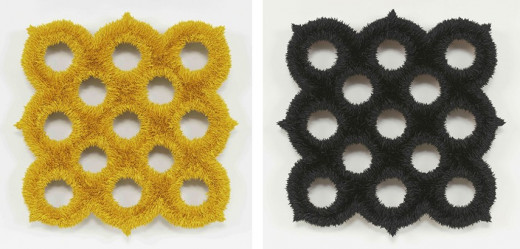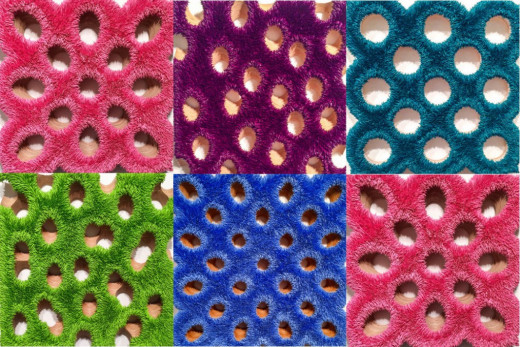Donald Moffett by Emily Elliott


Often times lately, my conversations with other artists turn to topics of material and surface texture. In such a recent conversation, someone shared excitement with me about Donald Moffett’s peculiar paintings which are referred to by the artist as ‘shag monochromes’. As told to me, these paintings are described as being highly textured, seeming to be factory-made. They appear as if they’re plaques of Astro Turf or some variety of plastic fiber that is not immediately, or ever, quite nameable, but is immediately attractive and intriguing. These are however made of oil paint. This oil paint is extruded from a kind of piping tip, as one would expect to be used by a baker or pastry decorator, and the culminating result takes the form of chromatically intense, uniform, and highly glossy “strands” that look quite like artificial grass.
I was recently able to see these paintings for myself. At first, a singular painting was seen at The Armory Show’s Contemporary wing at Pier 94 where the artist was included in a group showing by his representing gallery. Then a whole host of the shag monochromes appeared at the ADAA Marianne Boesky Gallery booth where Moffett was the spotlighted artist, filling the entire space with his attention-grabbing pieces.
It is true that these paintings are interesting and mysterious in texture and presence. In addition to the extruded strands, the paintings’ supports are also characters of curiosity. Like a more traditional painting the paint is applied on linen, though this linen is backed with thick plywood. This whole support structure is then drilled through to leave wide gaping tunnels (sometimes drilled perpendicular to the picture plane and sometimes drilled at an angle) which reveal the thin layers of wood that are laminated to build the depth of the plywood. After this drilling, the paint is piped in a very regular and ordered way so that the strands are nearly identical, creating a carpeting effect across the surface of the canvas. Around the periphery of the drillings the paint strands sort of ‘fall in’ to the hole, their tips bending to point into the void but mostly staying out of it.
As this system of creating is established the artist goes on to make variations on theme. Here’s one done in pink. Now one in silver. Then lavender, followed by a green so deep it is almost black, a white, and an orange one. Maybe one has a lot of drilled holes, and then the next has only one hole. This one has holes that only cut away the very edge of the canvas, and that one has only centrally contained holes. Then, there are a few variations of the edge of the canvases-a scalloped edge, a Moroccan tile sort of arabesque edge, a straight-cut edge, one with tunnels that radiate from center to edge. There’s just enough variety provided to let us know that the artist isn’t making quite the same piece over again.
As I reflect on this, I’m reminded of Chuck Close’s advice to his younger self (CBS News, April 10, 2012) in which he says to “sign on to a process and see where it takes you.” Does Moffett have the same intention here as Close in making so many variations, slight as they are, on the same system? Is he exhausting all possibilities of the process so that he may inadvertently (or quite deliberately) discover a revelatory new tangent that will transition into a different body of work or bring this one to a fresh intersection with something else?
It is my hope that this ‘signing-on and seeing where it goes’ is a definite concern of Moffett’s, especially in reference to this particular collection of pieces that are quite solidly ‘signed on’ to the particular process of paint-extrusion and support-drilling. I hope that these multiples are his explorations of how this system can manipulate and how it can deviate in incremental steps that will eventually reward repetitive efforts with a uniquely distinct “eureka”. And if they are not-if they are autonomous entities meant as ends unto themselves-I say that he then is losing the artistry and poetry of what that initial system sparked by turning it into a commodity of quantity.
In reference to this speculated commodification, I take particular issue with the introduction of variation which is not actually varied enough to constitute meaningful difference between the pieces. Because this variation is so slight, the variation itself does not act as a stand-out quality to differentiate one piece from the next. It instead dulls the potency and impact of the system’s key players by making them seem commodified in that the unique quality of the material is exploited in too many possible (but really the same) forms.
Absolutely, I believe that Moffett should exhaust all possible and potential deviations of his theme. I’m convinced that this taxonomic approach can be crucial to the growth and development of this process and employment of material. But do we as viewers need to see all of it? Do we need to see so much of what may happen behind the walls of the studio?
To let us in on so many of the constricted variations leaves me to feel like the artist is concerned too closely with output and maximizing product. I realize that Piece A isn’t so special because Piece B, right next to it, wants to be unique but really isn’t. For this reason, seeing the lone piece at the Armory Pier was a treat-all of the interesting aspects of the painting were fresh and novel in their unfamiliarity. However, when I was able to view the whole sampling of the too-many shag monochromes at the ADAA booth, disappointment was felt as I was made aware that what I previously thought was a rare mode of making was actually quite commonplace in Moffett’s artistic practice. By the end of it all, I’m reminded of a Happy Meal toy given to a child, which at first is a source of excitement, but too quickly loses its appeal for something more interactive and engaging.
At first introduction, Moffett’s shag paintings really are something a viewer can be excited about. But when we’re given too much without enough substantial variety, the sparks that could be powerful fade to mundane more quickly than one would hope.





